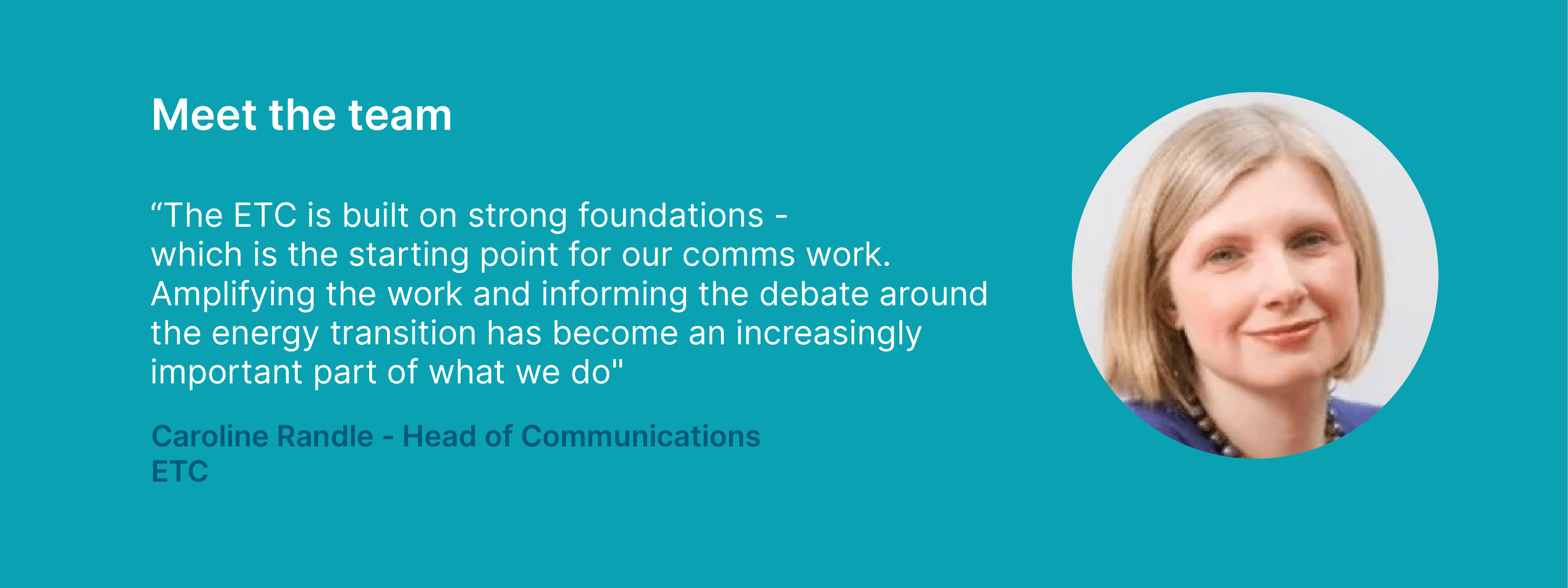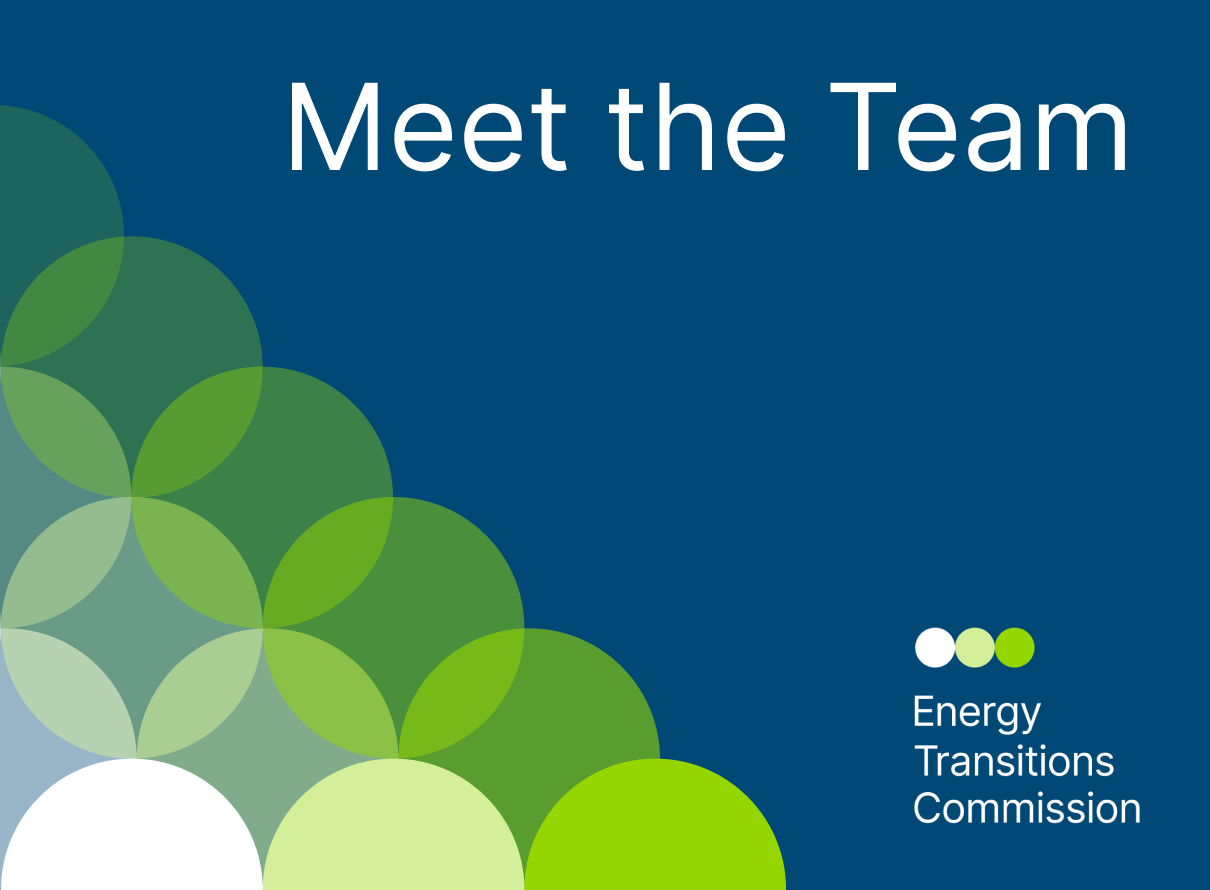Today we introduce Caroline Randle, Head of Communications at the ETC. For the last three years, Caroline has spearheaded communications efforts, amplifying the ETC’s messages globally. Caroline is behind the launch of many ETC flagship reports and series including Making Mission Possible, The Mission Possible Series, The Keeping 1.5 °C Alive Series and the Barriers to Clean Electrification Series.

- What made you join the ETC?
Over the previous decade I’d increasingly worked with organisations that were either energy companies or focused on environment and sustainability issues, whether they were corporates, trade associations or charities.
In addition, and when my children were school age, I’d worked as a freelance and interim for 10 years and I was at a stage where I was looking for a new challenge and keen to work as part of a comms team in an in-house role again. So, when I saw the job at the ETC, it provided an opportunity for me to harness all my experience and contribute to an organisation with a mission-driven purpose. It just seemed like the job for me.
Some of it was timing but when I met the senior team and found out more about the role and remit, I believed it would be somewhere where I could make a difference and there was important work to be done in terms of communicating about the energy transition.
Sometimes in interviews, you get asked “what’s your dream job?” and actually when I put all those elements together, this was the dream job. It was the job I was looking for. I felt it I didn’t go for it, then I would always regret it.
- What’s your proudest achievement to date at the ETC?
Well, there are a number of things. First, the launch of Making Mission Possible, which was the follow-up from Mission Possible. It was a much-awaited report in its own right and it really underpinned those core messages that it’s economically and technically possible to reach net-zero by mid-century. It really positioned clean electrification as at the heart of the energy transition and led to the rest of the Mission Possible Series –Clean Electrification, Hydrogen, Bioresources, CCUS.
Also, I hadn’t been here very long at that stage and the work was all done during COVID times as well. So there’s a certain sense of achievement and showing the power of the team that we were able to do that against the backdrop of such uncertainty.
Then secondly, just the breadth and quality of work that we have produced over the last three years. The ETC is built on strong foundations – our analytical work and evidence-based perspective, which is the starting point for our communications work. Amplifying that work but also contributing to the debate around the energy transition has become an increasingly important part of what we do. Sometimes for reasons we didn’t anticipate, such as the Ukraine war, which put energy security front and centre. From a communications perspective, it is important to keep repeating our messages and to use different channels and formats to target a broader audience.
And finally, the launch of the Mission Possible Partnership, was exciting and it was a great opportunity to collaborate with colleagues from RMI, We Mean Business and World Economic Forum as well as the ETC team led by Faustine Delasalle and Alasdair Graham. Our sector specific teams focusing on industries including steel, aviation and shipping have achieved a great deal in a short space of time and it has been rewarding to support their efforts.
- What does the energy transition mean to you?
To me, it’s really the journey to establishing a net-zero economy by mid-century and the actions needed from policy makers, corporations and civil society to make that a reality. Looking at not just the near term, but also the longer-term targets and the impact of those targets on the ground in terms of speeding up action.
As 2030 moves more sharply into focus we are at tipping point in terms of driving action, it is no longer enough to say we need to go further faster, we now have to see the energy transition in action in terms of real-economy projects and look to scale the investment, technology and the market needed to achieve progress.
- On the pathway to net zero, what do you see as the biggest obstacle?
There are several challenges and these are highlighted in our Barriers to Clean Electrification series.
Our recently launched Insights Briefing, Streamlining planning and permitting to accelerate wind and solar deployment, highlights how governments, civil society and wind and solar developers can take action to reduce unnecessary delays caused by common planning and permitting barriers in renewables deployment whilst maintaining strong environmental, biodiversity and social safeguards.
Other obstacles that need to be addressed quickly are finance and supply chain issues. Both of these subjects will be addressed by the ETC over the coming months.
- What are you most excited about that’s coming up from the ETC?
I am looking forward to our Financing the Transition report that we will be launching in March along with the work that our sector teams are doing on Breakthrough Steel Investments, focusing on what it’s going to take to scaling up near-zero emissions primary (ore-based) steelmaking and develop and scale the number of plants we need to achieve net-zero targets.
I’m also excited by the fact that we’re now able to travel and meet our colleagues and members in other countries. The progress in Australia, following the last election is particularly encouraging and we are currently working with the Australian Industry Energy Transitions Initiative (ETI) there on the launch of a new report, Pathways to industrial decarbonisation: Positioning Australian industry to prosper in a net zero global economy. Australia is rich in natural wind and solar resources and has a bright economic future as a result of the energy transition.
- What’s the best piece of advice you’ve received from an ETC colleague?
There are two guiding principles that I regularly apply and are based on advice from ETC colleagues.
Firstly, are we adding value to the debate by the work we are doing? And secondly, the comms person’s mantra of repetition, repetition, repetition. Just because we are all familiar with a message not everyone else is and there is always work to be done spreading the word.


